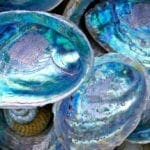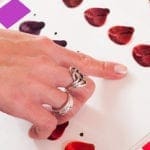Vintage pearls come in many sizes and colors, just as today’s pearls do. There are some vintage types which were usual and therefore notable. For example, baroque pearls, which were the norm during the Baroque and the following Renaissance periods, and which derive their name from the Portuguese for imperfect pearl, were also fashionable during the Renaissance revival period. It was not uncommon to have entire pieces made from a Baroque pearl. Art Deco and Art Nouveau pieces were often the result of naturally occurring Blister pearls. Blister pearls were created when an organic bit of detritus attached itself to a mollusk’s shell. Often they were not uniform in shape. After the 1920s culturing of pearls slowly came into vogue and more and more blister pearls were man-made rather than natural. Vintage cultured pearls are made as they are today, by placing a small bit of matter, such as a bead, or a sliver of shell into an oyster or clam. The mollusk reacts as it would to any such intrusion in the wild and over time a pearl is the result. Fine jewelry from the 1800s onward were often the result of using freshwater pearls, which have a naturally rocky shape. Blister pearls that are harvested by cutting them away and sealing them with mother of pearl are called Mabe pearls, which are also found in older pieces.
Key Takeaways:
- Understanding how to pair jewelry with a certain outfit is really important in life.
- Some people do not know how to wear the pearls that are given to them from elderly people.
- In modern times, pearls have not been popular but they are starting to make a bit of a comeback.
“Pearls set into antique and vintage jewelry come in all shapes and sizes, and some of the same terms are used to describe those used in both fine and costume jewelry.”
Read more: https://www.thesprucecrafts.com/identifying-pearls-used-in-antique-and-vintage-jewelry-4119948











